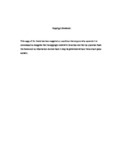Light Dance: Beyond the Dichotomy of Light and Vision
| dc.contributor.supervisor | Phillips, Mike | |
| dc.contributor.author | Riskin, Seth | |
| dc.contributor.other | School of Art, Design and Architecture | en_US |
| dc.date.accessioned | 2021-09-14T07:29:13Z | |
| dc.date.available | 2021-09-14T07:29:13Z | |
| dc.date.issued | 2021 | |
| dc.identifier | 10473171 | en_US |
| dc.identifier.uri | http://hdl.handle.net/10026.1/17787 | |
| dc.description.abstract |
ABSTRACT Light Dance: Beyond the Dichotomy of Light and Vision Seth Riskin This practice-based dissertation focuses on Light Dance, an original artistic practice developed by the author that, in reducing light to its core elements in a setting devoid of other sources of illumination, centers the equivalence of light and vision in experience. Moving with projection instruments attached to his body, the artist articulates geometrically elemental light forms on the boundaries of the room. Through unique artistic technologies and methods, Light Dance creates a visual environment in which light is perceived as a reflexive experience of vision, an inversion of our ordinary visual experience. These Light Dance experiences—shaping as they do primary perceptions of space and time through the manipulation of light—speak to the early visual system of the brain, provoking new concepts. In turn, the author shows how this inverted perspective has implications for the epistemic paradigm under which light and vision currently operate, especially as reflected in the relationship between visual art and vision neuroscience. To come to a realization of this inverted order, the research undertaken in this study pursues a reflexive process applied to the Light Dance practice, where the artist’s writings, illustrations, and photo documentation of past performances are used to generate a series of postulates testing this refined understanding of light and vision. Working closely with this documentation, the author builds upon the postulates to a thesis statement proposing a principle of equivalence between light and vision. The postulates and thesis are subsequently tested through a series of light array experiments designed by the author to photographically document and evidence details of the unique spatiotemporal perceptual experiences generated by Light Dance performances. Upon situating this reflexive study in epistemic evidence, the author then traces the genesis of this reflexive practice to forebearers in the Light Art tradition: Thomas Wilfred, László Moholy-Nagy, Otto Piene, and James Turrell. Examining how these artistic forebearers begin to establish a nascent practice of seeing into perception by working with light as a medium, the author then returns to reexamine Light Dance as a process of perceiving perceptual construction. By pursuing artistic practice in situ, Light Dance ultimately presents new knowledge concerning the relationship between light and vision as well as reworks the relationship between artistic practice and vision neuroscience, centering artistic insight not as corroboration of scientific theory, but as companion—and at times, as lead—to discoveries on the nature of perception. | en_US |
| dc.language.iso | en | |
| dc.publisher | University of Plymouth | |
| dc.subject | Light | en_US |
| dc.subject | Vision | |
| dc.subject | Perception | |
| dc.subject | Visual art | |
| dc.subject | Light art | |
| dc.subject | Vision neuroscience | |
| dc.subject | Early visual processing | |
| dc.subject | Inverse problem in optics | |
| dc.subject | Perceptual space and time | |
| dc.subject.classification | PhD | en_US |
| dc.title | Light Dance: Beyond the Dichotomy of Light and Vision | en_US |
| dc.type | Thesis | |
| plymouth.version | publishable | en_US |
| dc.identifier.doi | http://dx.doi.org/10.24382/385 | |
| dc.identifier.doi | http://dx.doi.org/10.24382/385 | |
| dc.rights.embargoperiod | No embargo | en_US |
| dc.type.qualification | Doctorate | en_US |
| rioxxterms.version | NA | |
| plymouth.orcid.id | 0000-0002-9031-0488 | en_US |
Files in this item
This item appears in the following Collection(s)
-
01 Research Theses Main Collection
Research Theses Main


